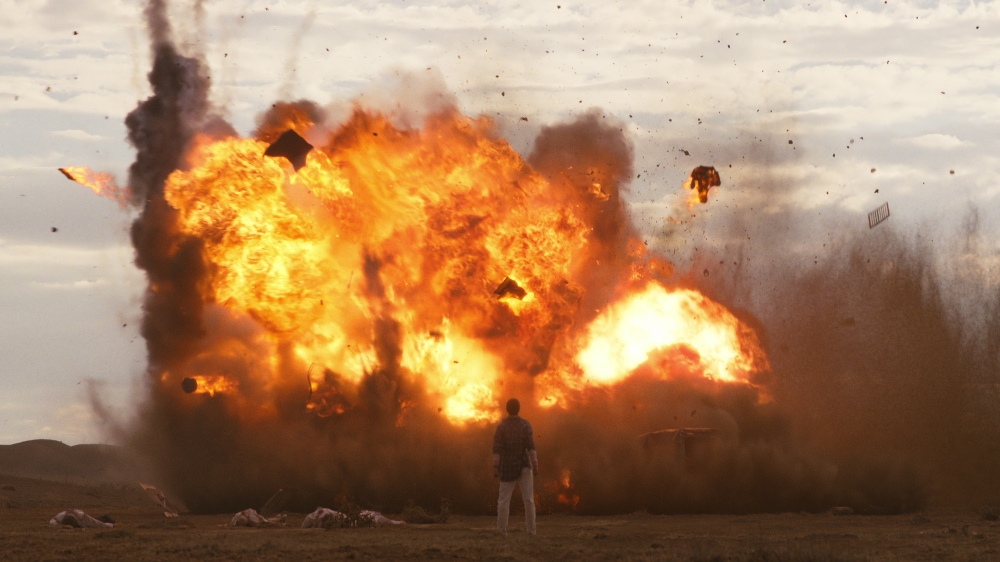
Following a long COVID delay, Stranger Things 4 finally premiered in May nearly three years after Season 3, with two volumes, no less, to keep in suspense regarding the fate of Hawkins. On July 1, the Duffer brothers unleashed the explosive finale, which saw Eleven and her friends battling an onslaught of evil forces, including Vecna, who was dead set on destroying them limb by limb.
Megafans of the supernatural will no doubt be impressed by some of the cool and creepy special effects that spice up the second half of Season 4, courtesy of the London-based special effects house Scanline VFX, which is led by Australian-born VFX supervisor Justin Mitchell. Mitchell earned an Emmy nomination and two VES Awards nominations for his work on the HBO series The Nevers, and won a VES award for Bury My Heart at Wounded Knee back in 2007.
In Stranger Things 4, Mitchell’s main directive was to not only blow things up with aplomb, which he admittedly delights in — namely helping Eleven take down a helicopter that crashes in a fiery explosion — but also to create the visualizations that depict the show’s signature strange goings-on with environment enhancements and extensions.
A film enthusiast who was inspired by VFX-heavy films such as Star Wars, The Terminator, and Avatar, Mitchell had the opportunity to combine his technical and artistic prowess, bringing together computer graphics and storytelling in designing effects worthy of a blockbuster film. Indeed, both Episodes 8 and 9 of Stranger Things 4 are feature-length, with the finale running almost two-and-a-half hours long.
Below the Line spoke with Justin Mitchell via Zoom from his home in Los Angeles, where he shared his VFX secrets (SPOILERS LURK BELOW!) in creating a more cinematic, Hollywood-esque feel to the show, from the rifts that carve up Hawkins to the desert raid on Papa’s compound to Vecna’s slithering vines that strangle the Creel House.
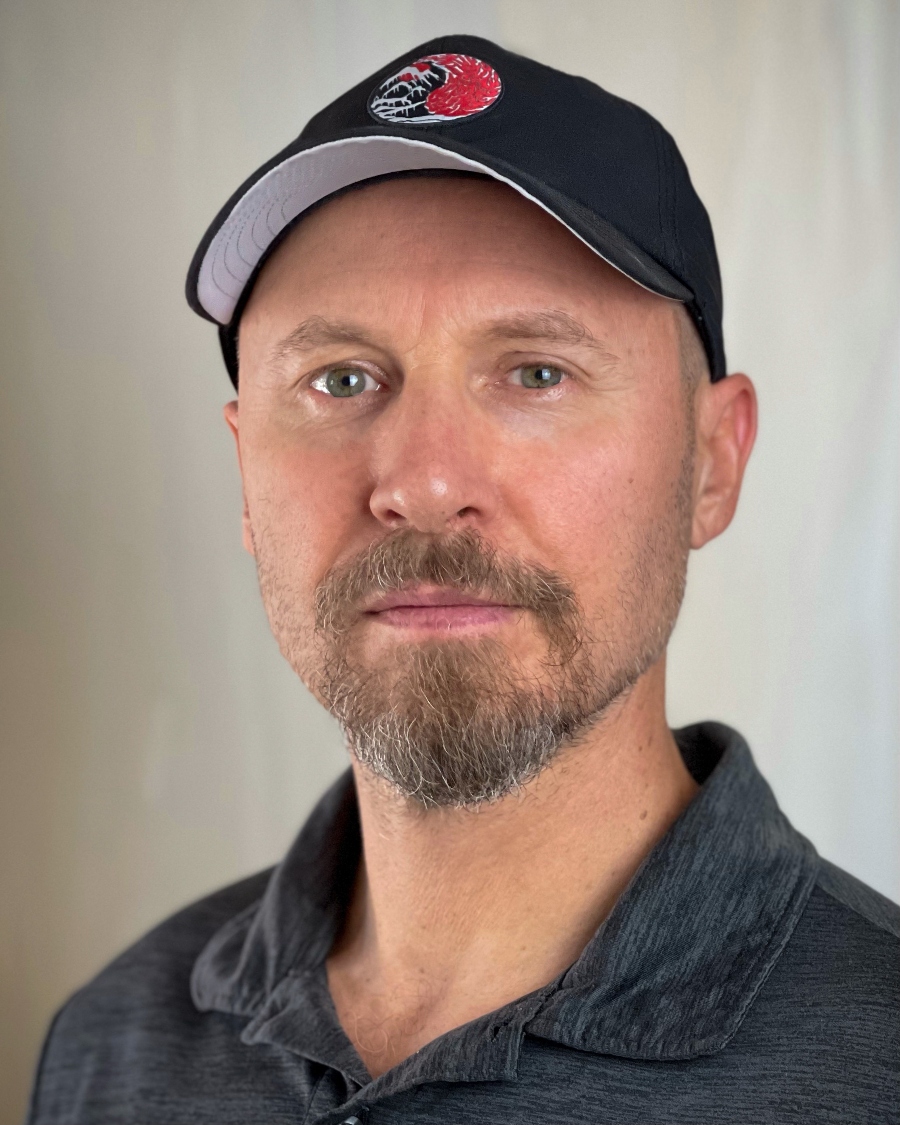
Below the Line: How did you first get involved with Stranger Things?
Justin Mitchell: Our German division had worked on Stranger Things 3. We had done some work in the Russian rift chamber where the gun explodes and, at that point, we’re led to believe [Hopper] has died as a result. We had done work on that season so we picked up from there from our Los Angeles offices. I work with teams that are in North America, mostly with the Canadian and Los Angeles divisions.
BTL: What were the initial conversations in laying out the groundwork for the special effects?
Mitchell: There was a lot of getting up to speed with the language of Stranger Things about what the Duffers like and what they don’t like, kind of the rules of that world, in addition to going through the sequences that we were going to be working on and starting to talk about development for the sequences.
BTL: Can you describe what some of those rules were?
Mitchell: Stranger Things has got this very specific imagery. They’ve got these two worlds that coexist — the right side up and the upside down. The upside-down is defined by a look classically like the red lightning in the clouds and a very desaturated blue pallet with spores that are floating around. It’s dark and horrific in its visuals. The rifts [that] we did a lot of work on are defined by these sort of organic structures that are kind of almost like snakes and webbing that blur between their world and our world. They’re sort of slimy and organic in nature. So it’s really exploring that language.
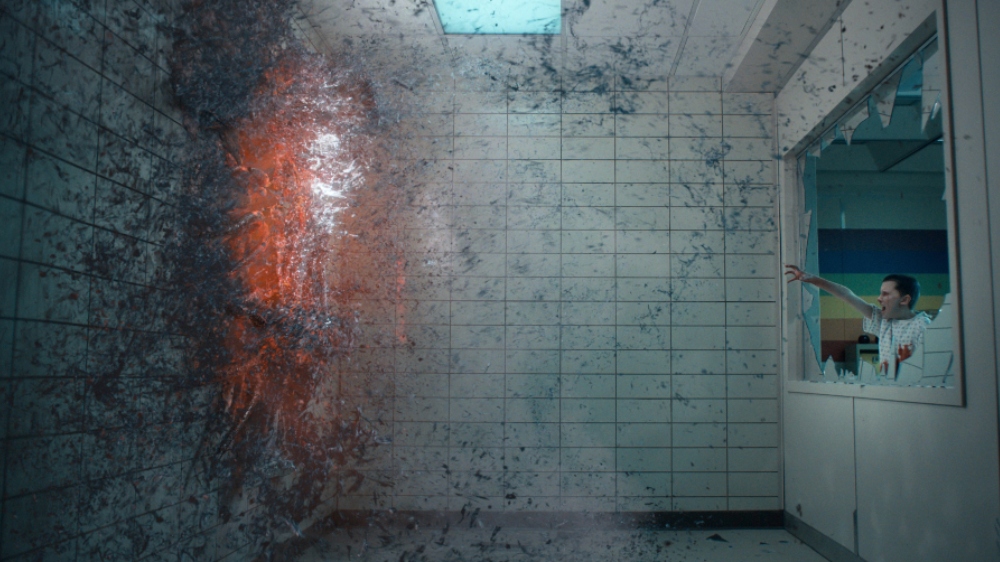
BTL: What were you most challenged by?
Mitchell: The rifts that we did in Season 4 are pictured at many different sizes and shapes, and appear in a lot of different materials at different scales. It was really about defining common language between the rifts regardless of how they’re pictured, and developing the tech involved in creating those elements were the biggest challenges.
BTL: Were you nervous about any of the decisions you made?
Mitchell: I always kind of feel like that. It was really an ambitious undertaking in this season. There are more visual effects in the last episode of Stranger Things this year than there were, I believe, in the whole season. It’s a whole different scale that they’re operating at now so that always creates time pressure. There’s a lot to do and never enough time. Some of the effects work that we’re doing, particularly in Episode 9, where the rifts all converge towards downtown Hawkins, are really on the scale of ten-fold feature films.
BTL: Are the lines blurred between television and film when it comes to special effects?
Mitchell: I’m not even sure what television means anymore. Streaming has now blurred the lines between television and feature films. The budgets are pretty much the same, and, of course, all of the big players like Disney and HBO, Apple, and Amazon, are all creating these humongous streaming series now. It’s a game changer. I actually started in television working on Charmed and Buffy the Vampire Slayer, where we would do a visual effect shot in a whole day. You would get a plate and track it and make some sort of effect and then composite it and shoot it out all within one day. That doesn’t happen anymore.
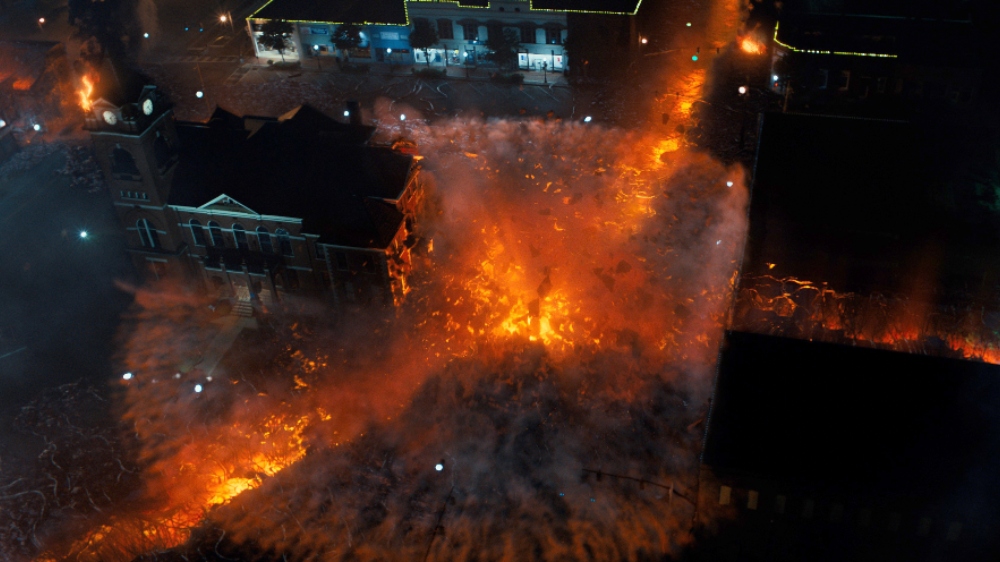
BTL: Are you the go-to guy for fantastic effects?
Mitchell: Yeah, I guess so. Our company [Scanline VF] is very well known for doing large-scale effects work. So if you’re gonna be flooding a city or having monsters in a city or have superheroes battling it out on a planet, we’re the people you would talk to, probably. I’ve worked across a lot of different genres over the years. Of course, as visual effects artists, you tend to work on a lot of superhero movies and fantastic types of effects. That’s really what I’ve done more of rather than invisible or naturalistic effects. I’ve certainly done my share of that as well.
BTL: Take me through some of the effects that you designed for Season 4. Let’s start with Episode 1.
Mitchell: The work that we did centered around the research center where the kids were being trained to be these super soldiers, if you will. Ultimately, what we did is a lot of the breaking of limbs and the augmentation of the broken tiles that define the hallways of the research center. When One goes on this rampage and kills a lot of the orderlies and the other [numbered] kids in the research center by lifting them up and snapping their limbs with telekinetic powers. We didn’t do the shots where you see the breaking of the limbs, but we did the aftermath.
We did kids lying in pools of blood in unusual-looking poses to make it look like their arms and legs had been broken. That was all done through a culmination of 3D modeling, then matte painting and projection. We also did a shot early on when Eleven is in California, sitting in her room, and the camera does a big dolly move down a hallway; we created a CG door that they weren’t able to put in because there wasn’t enough room for the camera to go by. That’s an example of [how] sometimes we forget that there are lots of little visual effects shots along the way, like set extensions or environment work. It’s not always big explosions or destruction, which are fun.
BTL: What did you design for Episode 2?
Mitchell: We revisited the work that was done by our brothers and sisters in Germany in the Russian rift chamber. That was revisiting that sequence and showing how Hopper survived the explosion of the Russian gun. We started that with an asset that was already in place, but the Duffers really wanted to reinvent the explosion to make it a little more classic Hollywood cinema. In Season 3, it appeared more kind of like an electrical kind of event, whereas in Season 4, it’s more like classic fireballs, smoke, and fire; really trying to tell the story of the event of the gun exploding and chasing Hopper as he ran for his life. We did a lot of fluid simulations for smoke and fire and debris simulation. That whole environment is pretty much completely CGI, largely just shot in front of a blue screen running down the platform and everything else is all computer generated.
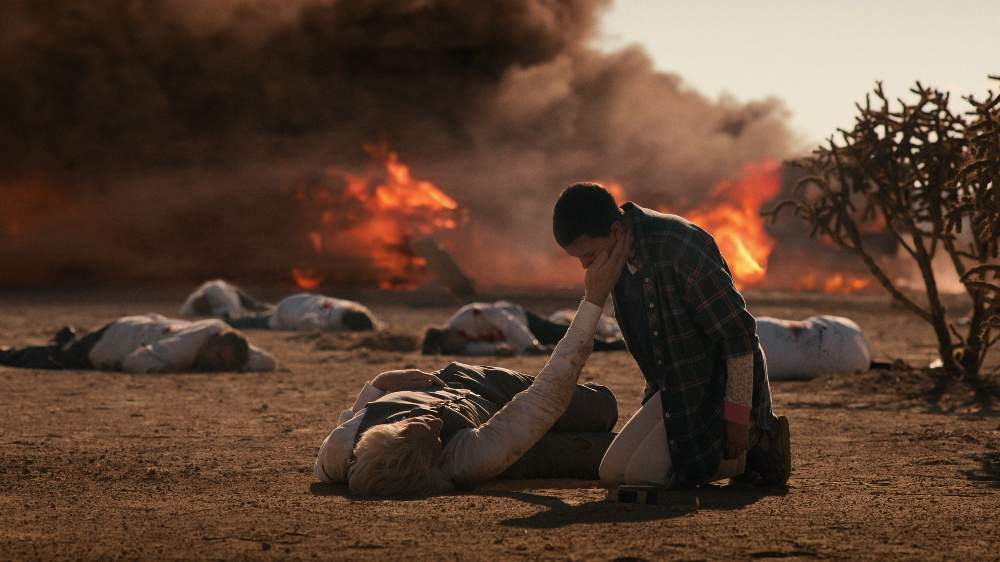
BTL: Episode 7 has one of the coolest effects, where you have One erupting into ashes and then dissipating. How did you do that?
Mitchell: It is a fun effect. That effect was revisiting an effect that was seen in Season 1 or Season 2, when Eleven fights a Demogorgon and she turns it into ash. Back in those days, they didn’t really have big-budget visual effects, so the actual Demogorgon was just a guy in a suit and the effects work was CGI, but done as an overlay over the disappearing of the Demogorgon. You didn’t get to actually see the creature getting torn apart the way that we do in this season. It was filmed with the actor (Jamie Campbell Bower) in place on a wire rig held up against the wall. We recreated a digital version of him and animated [it] to match his movements. The effect of him tearing apart is really like a particle system that was done [using the] Houdini effects tool, in addition to some clever layering of textures and materials.
BTL: What about the breaking glass effect where One’s body gets thrown back into the mirror?
Mitchell: They actually did do a stunt with a person getting thrown through sugar glass. The problem is, that never looks very good. You don’t want anyone to get hurt so, of course, it’s not real glass, so it never creates sharp edges. It is helpful for timing and sometimes you need it to extract reflections and for good reference. We had a CG replica of that room and of the actor who was match-moved to doing the same thing the stunt person did, and then the mirror was basically a rigid body simulation that was interacting with the match-moved version of the digital character.
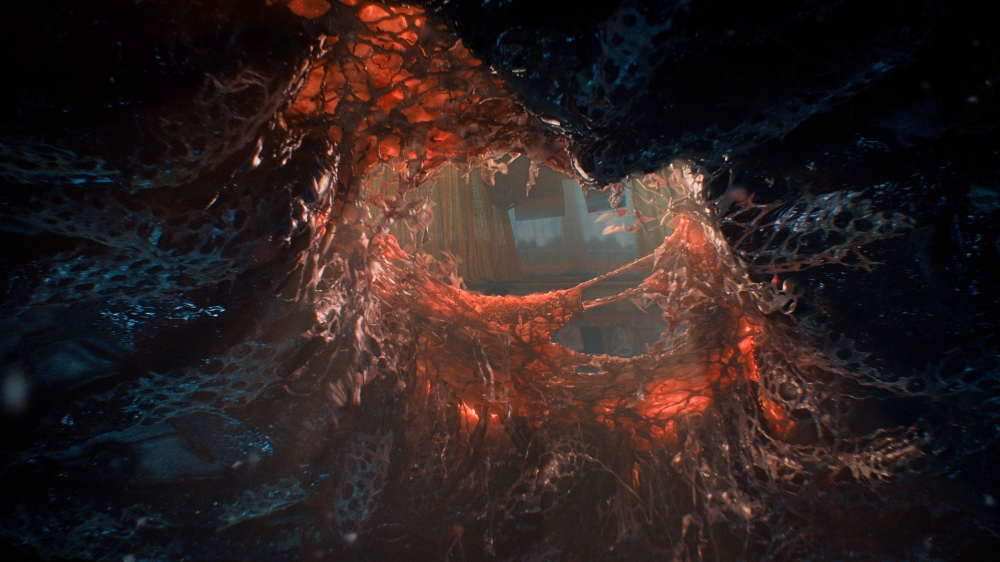
BTL: Moving onto Episode 8, which involves Eleven taking down a helicopter. How was that effect achieved?
Mitchell: They did have a helicopter on set but didn’t use it for all the shots that they needed. They didn’t actually crash the helicopter. They did have a practical explosion, which we augmented. For half the shots in that sequence, the helicopter is CGI. We did have a practical helicopter to match to, which is both beneficial for a clear visual reference, but also an additional challenge because it really needs to intercut with the real helicopter. For the actual explosion, there were Humvees and a real explosion, but for the helicopter crash, [that] was animated by us and the effects work of it tearing apart with debris shooting out to the sides and additional fireballs and dust and sparks were all created by us. We did a digital replacement of the Humvees in the vehicles so that they would react to the helicopters striking them.
BTL: Now onto the grand finale of Episode 9, which is so creepy. How did you bring the Creel House to life like that with the Vecna’s vines covering it?
Mitchell: We did a digital replica of the inside of The Creel House. When they filmed it there were practical vines done by the art department, which is very familiar with dressing the upside-down world in Stranger Things using these vines that they’ve developed over the years. We matched the practical vines on set, which appear throughout the season and are an extension of Vecna and part of his hive mind. We were shown a lot of imagery of concept art and other development that had taken place on the vines. We were largely building off of that.
In this particular sequence, the vines needed to be moving and also needed to grab the kids and pin them against the wall. We added digital vines that were slithering and crawling along the floor and up the stairs, anywhere the kids were to be walking. We needed to strike a balance between making something that felt organic and alive but also needed to match the wall’s practical aesthetic on the set. We match-moved all the actors so that the vines would get proper shadows and reflections of the actors. A particular challenge was that the actors had flashlights and so we had to match-move all of the flashlights and, of course, in the upside-down world, [there] are all these CGI floating spores, so the flashlights needed to illuminate the vines that were on the stairs and the floor as well as the spores.
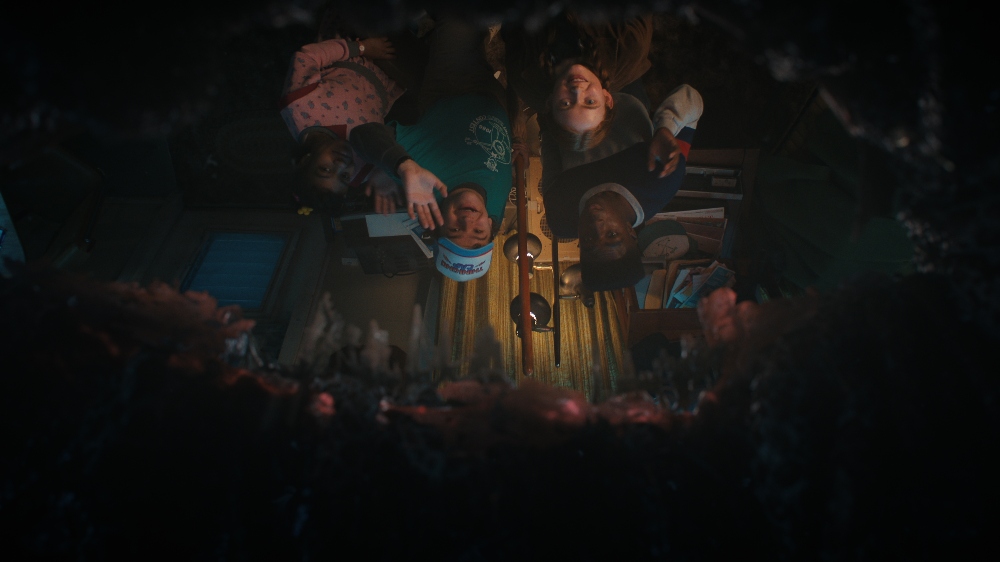
BTL: (AGAIN, SPOILER ALERT!) How did you animate the rifts that tear through Hawkins for the ultimate disaster?
Mitchell: We did the rift in Eddie’s trailer that the kids sort of travel between in Episode 7. When One is fighting Eleven, she opens the rift through him in the Rainbow Room. That’s where he gets pushed through this gap in the wall and goes through this world where he’s getting torn apart and transforming into Vecna. We did the rift that is formed in his wake.
For Episode 9, we did a dozen or more rifts all the way from the rifts that originate in the attic of the Creel House and ultimately slice Jason in half. Then the rifts that tear apart Eddie’s trailer and travel through the trailer park. The rifts that form in the lake that ultimately appear [to make] waterfalls, as the rift tore through the water. Then, of course, the rifts that ultimately converge in downtown Hawkins with trees and cars and buildings all falling into the rifts. That’s an example of where the challenge really lied because the rifts have these different elements in them.
There’s mold that grows out that frames the rift, if you will. There are these vines that creep up out of the rift as it starts to form. There’s a membrane which gives the barrier between the right side up and the upside down. That’s really the doorway between those two worlds so as things fall into the rift they actually have to interact with the vines and the membranes. We had to explore what that reaction would be and ultimately found out the interaction needed to be minimal because it would be too distracting to have a membrane bouncing around all over the place. It needed to be a consistent barrier.
BTL: When you look back at your work, what are you most proud of?
Mitchell: I come from a CG background so that’s really my strength and specifically from an effects background so I really know the tools of the trade there and what can be utilized effectively to pull off the shot. Personally, I have a strong eye and an ability to design an interesting and engaging effect to do the best we can with what we got. The visual effects in Stranger Things, whilst they are fantastic in engaging part of the story, I don’t think it’s what makes the show beloved.
It’s the relationship between the kids and the great storytelling that goes on with what the Duffers created. I think the visual effects really serve to create the backdrop for those things to happen with a lot of visual eye candy and adventure as part of it. It’s really more of an adventure show than a horror show and we get to look at some pretty strange things (pun maybe a little bit intended) on a daily basis. The effects define the stakes of the drama that they’re living in. It’s as big a cliffhanger as you can have! I’m very excited to see what happens in Season 5.
Stranger Things 4 is now streaming on Netflix.
https://www.youtube.com/watch?v=yQEondeGvKo





